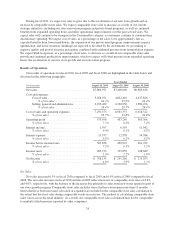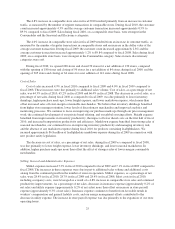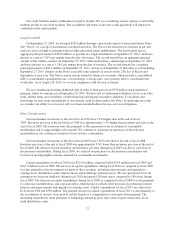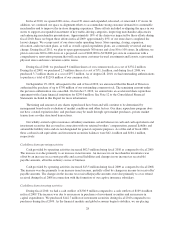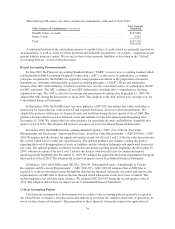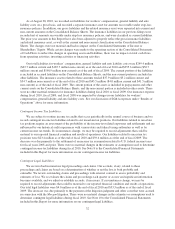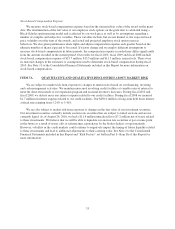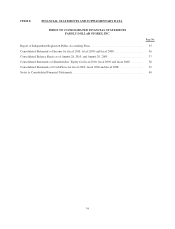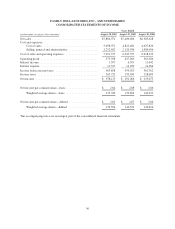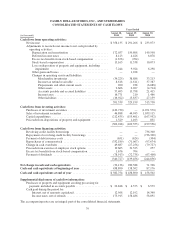Family Dollar 2010 Annual Report Download - page 34
Download and view the complete annual report
Please find page 34 of the 2010 Family Dollar annual report below. You can navigate through the pages in the report by either clicking on the pages listed below, or by using the keyword search tool below to find specific information within the annual report.
The following table shows our other commercial commitments at the end of fiscal 2010:
Other Commercial Commitments (in thousands)
Total Amounts
Committed
Standby letters of credit .......................................... $153,882
Surety bonds ................................................... 3,419
Total ......................................................... $157,301
A substantial portion of the outstanding amount of standby letters of credit (which are primarily renewed on
an annual basis) is used as surety for future premium and deductible payments to our workers’ compensation and
general liability insurance carrier. We accrue for these future payment liabilities as described in the “Critical
Accounting Policies” section of this discussion.
Recent Accounting Pronouncements
In June 2009, the Financial Accounting Standards Board (“FASB”) issued a new accounting standard which
established the FASB Accounting Standards Codification (“ASC”) as the source of authoritative accounting
principles recognized by the FASB to be applied by nongovernmental entities in the preparation of financial
statements in conformity with generally accepted accounting principles (“GAAP”). Rules and interpretive
releases of the SEC under authority of federal securities laws are also considered sources of authoritative GAAP
for SEC registrants. The ASC combines all non-SEC authoritative standards into a comprehensive database
organized by topic. The ASC is effective for interim and annual periods ending after September 15, 2009. We
adopted the ASC during the first quarter of fiscal 2010. The adoption of the ASC did not have an impact on our
Consolidated Financial Statements.
In September 2006, the FASB issued fair value guidance (ASC 820) that defines fair value, establishes a
framework for measuring fair value in GAAP and expands disclosures about fair value measurements. We
adopted the guidance with respect to financial assets and liabilities during the first quarter of fiscal 2009. The
guidance became effective for non-financial assets and liabilities for the first annual period beginning after
November 15, 2008. We adopted the fair value guidance for non-financial assets and liabilities during the first
quarter of fiscal 2010. The adoption did not have an impact on our Consolidated Financial Statements.
In January 2010, the FASB issued Accounting Standards Update (“ASU”) No. 2010-06 “Fair Value
Measurements and Disclosures—Improving Disclosures about Fair Value Measurements” (“ASU 2010-06”). ASU
2010-06 requires new disclosures for significant transfers in and out of Level 1 and 2 of the fair value hierarchy and
the activity within Level 3 of the fair value hierarchy. The updated guidance also clarifies existing disclosures
regarding the level of disaggregation of assets or liabilities and the valuation techniques and inputs used to measure
fair value. The updated guidance is effective for interim and annual reporting periods beginning after December 15,
2009, with the exception of the new Level 3 activity disclosures, which are effective for interim and annual
reporting periods beginning after December 15, 2010. We adopted the applicable disclosure requirements during the
third quarter of fiscal 2010. The adoption did not have an impact on our Consolidated Financial Statements.
In February 2010, the FASB issued ASU No. 2010-09 “Subsequent Events—Amendments to Certain
Recognition and Disclosure Requirements” (“ASU 2010-09”). ASU 2010-09 reiterates that an SEC filer is
required to evaluate subsequent events through the date that the financial statements are issued and removes the
requirement for an SEC filer to disclose the date through which subsequent events have been evaluated. The
updated guidance was effective upon issuance. We adopted ASU 2010-09 during the second quarter of fiscal
2010. The adoption did not have an impact on our Consolidated Financial Statements.
Critical Accounting Policies
Our financial statements have been prepared in accordance with accounting policies generally accepted in
the United States of America. Our discussion and analysis of our financial condition and results of operations are
based on these financial statements. The preparation of these financial statements requires the application of
30






